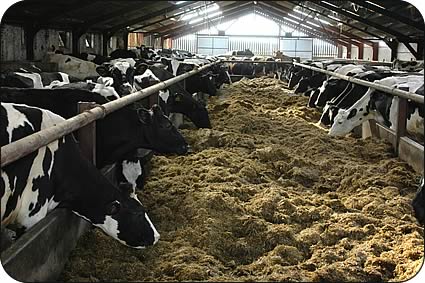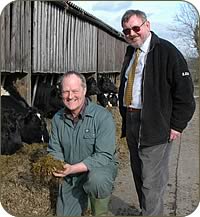Jennifer MacKenzie is an agricultural photo journalist with almost 30 year's experience. Operating from her base in Cumbria, Jennifer undertakes mainly industry-related freelance writing and photography.
Maximising milk production from grass
Producing more milk from grazed grass and silage on a low-input, low-cost system is the objective of Cumbrian producer Michael Harper, more so in the light of changes that will result under the new Single Farm Payment regime.
The results from grazing and cropping a newly-re-seeded 20-acre field have convinced Mr Harper that selection of the best new varieties can be a major factor in maximising milk production from grass.
 |
Since moving to their new farm, where re-seeds have been in use, yields have risen by 1,200 litres a cow off forage alone to a rolling average of more than 7,000 litres. In the current winter, concentrate feeding has gone down without detriment to yields, and this is all put down to better utilisation of grass.
Mr Harper and his wife Susan, who rely only on part-time labour, set about re-seeding 20 acres a year with medium to long-term leys when they moved to the all-grass farm at West House, Dearham, near Maryport in May 2002.
In August 2003, on the advice of specialist seedsman and Formula Leys director David Baldwin, they re-seeded a field with an Aber High Sugar Grass mix which during the following summer months increased milk production across the 130-cow commercial black and white herd by two litres per cow a day – the equivalent of more than £2,000 in extra income from milk.
During the winter cows have continued to milk well, with increased yields and butterfat levels being recorded when first cut silage made off the Aber High Sugar Grass ley has been fed.
“We moved from a farm with limited grazing to West House which is ring-fenced to try to produce as much milk as possible off good grassland and silage,” explained Mr Harper. “In addition to the improved grassland, we have gone for an easily managed system with low labour requirements.
“Previously we ran a mixed farm, milking 85 cows. Dairy herd numbers have been increased since the move and rather than keeping calves we are now selling our crossbred calves at about three weeks old at premium rates and concentrating on milk production.
“We tried the Aber High Sugar Grass mix with a view to getting good grazing for the milk cows. During its first winter it was grazed by sheep and it was our intention to graze it with the cows the following summer.
“However, it grew so well after the sheep were taken off in the early part of the year that we had to cut it for silage. It was cut on May 15, 10 days before the rest of the first cut crop.”
The first cut analysis had high D and ME values of 76 and 12.2 MJ/kg respectively, crude protein at 16% and pH of 3.7 at 30% dry matter with high intake characteristics – a potential intake factor of 115 – as well as good sugar levels.
The grass mixture was predominantly made up of the hybrid ryegrass AberStorm and the diploid perennial ryegrass AberDart, both being Aber High Sugar Grass varieties, along with the white clover blend AberPasture.
The Aber High Sugar Grass varieties are the result of 20 years of grass breeding at the Institute of Grassland and Environmental Research (IGER) at Aberystwyth to produce grass with higher water soluble carbohydrate (WSC) content.
 |
“AberEcho, which is another hybrid ryegrass, and AberStorm can be used for both cutting and grazing as Michael has proved in 2004,” said David Baldwin.
“Hybrids offer high levels of spring growth than perennial ryegrass in spring and head a few days earlier, but this can be delayed by grazing later if the field is going to be cut for silage.
“Another feature of hybrids is their erect growth habit which could be a contributory factor to extra yield. Cows only graze for a limited time each day and research has shown that they only take a certain number of bites per day.
“If what they are eating is not only more nutritional but lets them take a larger mouthful this will increase production.”
No additive was used in the silage making. The 20-acre field yielded 12 tonnes to the acre of grass, accounting for a quarter of the 1,000 tonne first cut crop.
Mr Harper mows the grass and allows it to wilt for 24 to 36 hours before it is picked up by St Bees contractor Tim West within the day.
Silage ground is fertilised with slurry and three bags to the acre of 25.5.5 NPK fertiliser, with grazing ground receiving two bags to the acre of the same compound.
The high sugar grass silage has been fed to the milking cows, with similarly impressive results.
“We have had better silage intakes than last year with much improved milk quality. Butterfats this winter have been extremely high at nearly 4.5 per cent with proteins at 3.25 per cent,” said Mr Harper.
The simple feeding system means that the silage is put into a large central feed passage every other day. On the alternate day the feed is ‘snow ploughed’ towards the feed barrier using a home made device on the back of the tractor
Concentrates are fed twice a day through the parlour at a current rate of 1.4 tonnes per cow per annum.
As well as the improvement from winter feeding of forage, the Harpers have also had the benefit of the increased yield from grazed grass over 45 days during June to September. At an extra two litres a day this brought in an extra 35p per cow per day at last summer’s milk price of 17.575p per litre for the predominantly spring calving herd.
“The high sugar grass must be more palatable because cows have a tendency to want to go back on these fields, even in preference to other recent reseeds. I have been very impressed with the grass for grazing and silage for the dairy cows as well as for the sheep.
“The field cost £100 an acre to reseed and it has more than paid for itself in its first year with the grazing. Any forage taken off it in the next three years a bonus,” added Mr Harper.
West House Farm runs to 170 acres in a ring fence and the Harpers also have 20 acres where they previously farmed and rent a further 50 acres.
They run a small suckler herd of 20 cows put to Limousin and Belgian Blue bulls with calves sold at a year to 18 months old, and 130 store cattle have been carried over from the mixed farming regime.

